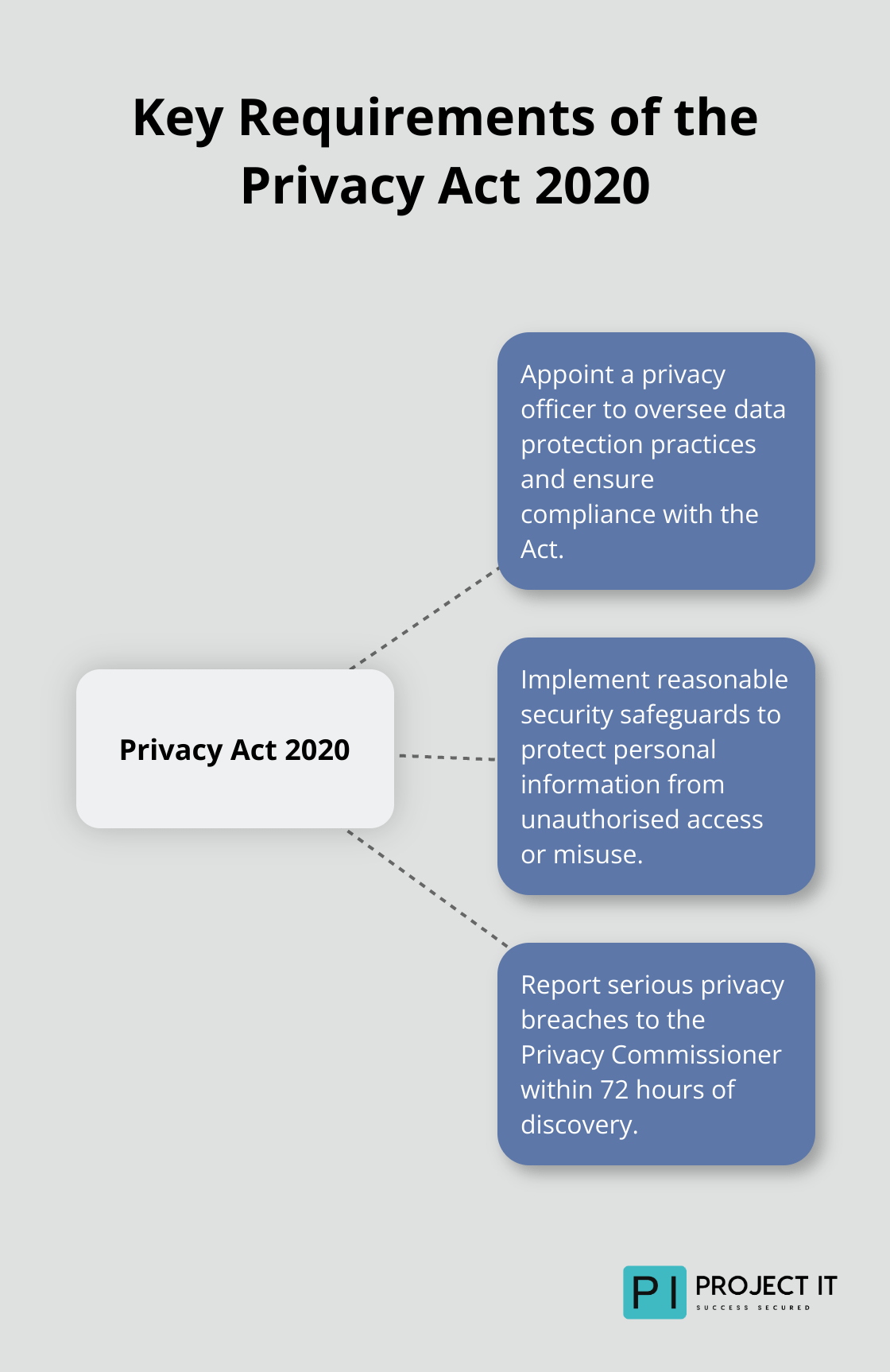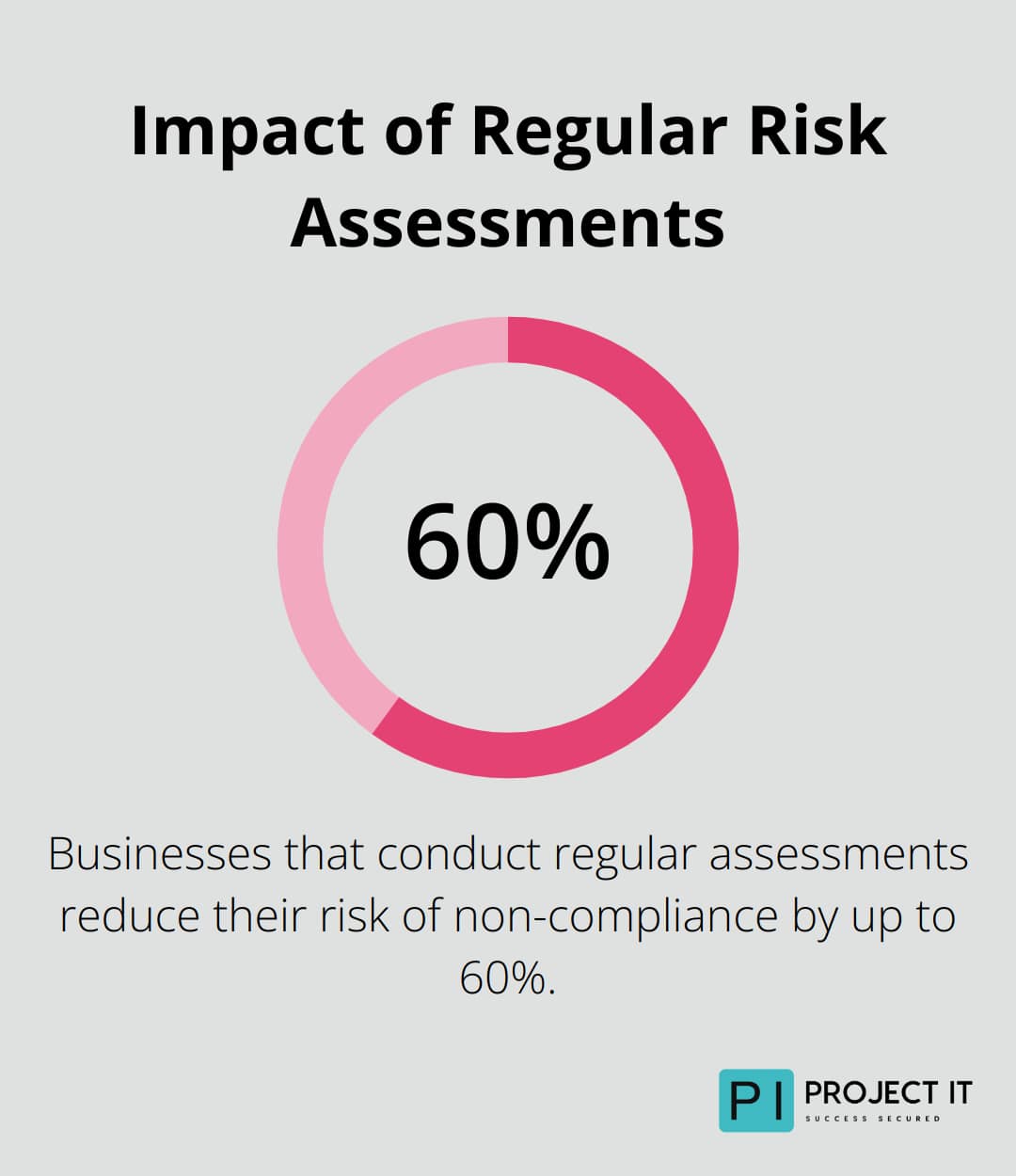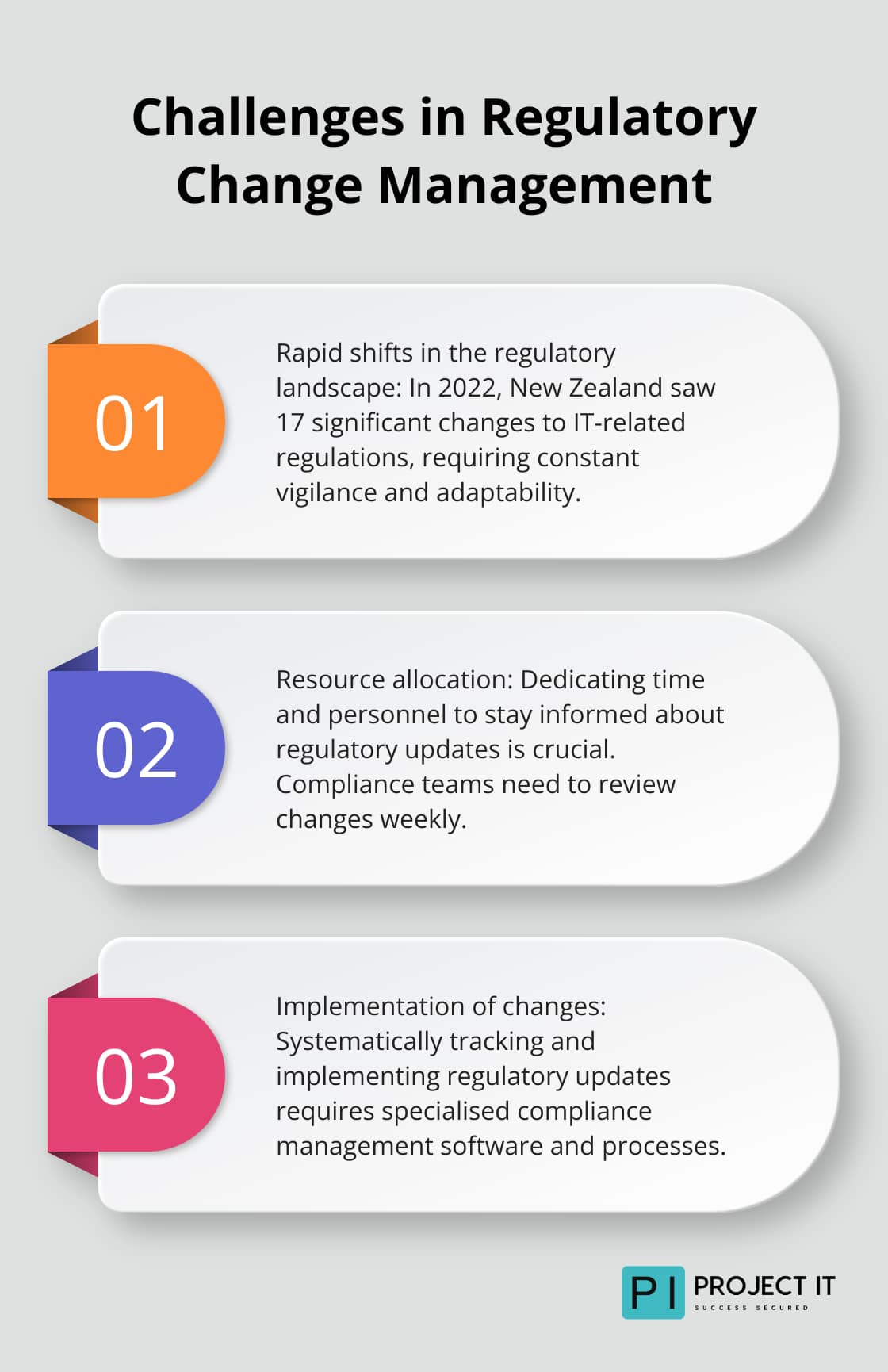IT compliance in New Zealand is a complex landscape that businesses must navigate carefully. With evolving regulations and increasing cyber threats, staying compliant is more important than ever.
At Project IT, we’ve seen first-hand how proper compliance management can protect organisations and boost their reputation. This guide will walk you through key regulations, best practices, and common challenges in New Zealand’s IT compliance realm.
What Are New Zealand’s Key IT Compliance Regulations?
New Zealand’s IT compliance landscape comprises several key regulations that businesses must understand and implement. Let’s explore the most important ones:
Privacy Act 2020
The Privacy Act 2020 forms the foundation of data protection in New Zealand. It applies to all businesses handling personal information, regardless of size. The Act requires that an agency holding personal information must not keep that information for longer than is required for the purposes for which the information may lawfully be used.
Key requirements include:
- Appointment of a privacy officer
- Implementation of reasonable security safeguards
- Reporting of serious privacy breaches within 72 hours

Health Information Privacy Code
This code establishes specific rules for handling health information. It’s particularly relevant for healthcare providers, insurers, and any business dealing with health data. The Health Information Privacy Code provides ethical guidance on collecting new data from participants and/or individuals and accessing and reusing data that has already been collected.
Rule 5 (often overlooked) requires health agencies to ensure security safeguards protect against loss, access, use, modification, or disclosure of health information.
Financial Markets Conduct Act 2013
This Act regulates financial products and services. It impacts IT systems that handle financial data or support financial services. The Act requires:
- Robust record-keeping systems
- Secure data storage and transmission
- Regular audits of IT systems handling financial information
Financial services firms can reduce compliance-related incidents through the implementation of tailored IT solutions.
Telecommunications (Interception Capability and Security) Act 2013
This Act primarily affects telecommunications network operators and service providers. It mandates:
- Interception capabilities for law enforcement
- Network security measures
- Notification of significant network changes
Even if you’re not a telco, this Act may impact your business if you provide any form of telecommunications service.
Understanding these regulations is just the first step. Effective implementation requires a strategic approach tailored to your business. In the next section, we’ll explore best practices for maintaining IT compliance in New Zealand (including tips on how to stay ahead of regulatory changes and minimise compliance risks).
How to Master IT Compliance in New Zealand
At Project IT, we’ve observed that mastering IT compliance in New Zealand requires a proactive, multi-faceted approach. Here’s how you can stay ahead of the curve:
Conduct Regular Risk Assessments
Don’t wait for a breach to happen. Perform thorough risk assessments at least quarterly. Use tools like Nessus or Qualys to scan for vulnerabilities. Businesses that conduct regular assessments reduce their risk of non-compliance by up to 60%.

Implement Continuous Monitoring
Static annual audits no longer suffice. Implement continuous monitoring tools like AlienVault or Splunk to detect compliance issues in real-time. These tools can help you spot and address potential violations before they escalate.
Train Your Team Relentlessly
Your employees form your first line of defence. Invest in regular, engaging training sessions. Interactive, scenario-based training increases retention by 75% compared to traditional methods. Use platforms like KnowBe4 or Proofpoint to deliver and track training.
Automate Where Possible
Manual processes invite errors and consume time. Leverage automation tools for tasks like log analysis, patch management, and access control. clients who automate compliance processes report a 40% reduction in compliance-related workload.
Document Everything
Detailed documentation proves compliance. Use tools like Confluence or SharePoint to create and maintain a comprehensive compliance repository. Include policies, procedures, incident reports, and audit trails. This aids in audits and helps quickly address any compliance gaps.
Encrypt Sensitive Data
With the Privacy Act 2020 in full effect, data encryption becomes non-negotiable. Use robust encryption tools for data at rest and in transit. We recommend solutions like BitLocker for full-disk encryption and SSL/TLS for secure data transmission.
Implement Strong Access Controls
Adopt the principle of least privilege. Use multi-factor authentication and regularly review and update access rights. Tools like Okta or Azure Active Directory can help manage identities and access across your organisation.
Stay Informed About Regulatory Changes
The compliance landscape evolves constantly. Subscribe to updates from the Office of the Privacy Commissioner and other relevant regulatory bodies. Attend industry conferences and webinars to stay ahead of upcoming changes.
These practices not only meet compliance requirements but also build a robust security posture that protects your business and builds trust with your customers. Compliance isn’t just about avoiding penalties-it creates a secure, trustworthy business environment.
As we move forward, let’s explore some common challenges businesses face in IT compliance and effective solutions to overcome them.
Overcoming IT Compliance Hurdles
Regulatory Change Management
The regulatory landscape shifts rapidly. In 2022, New Zealand saw 17 significant changes to IT-related regulations. To stay ahead:

- Set up automated alerts from regulatory bodies like the Office of the Privacy Commissioner.
- Allocate dedicated time weekly for your compliance team to review updates.
- Use compliance management software (such as Navex Global or MetricStream) to track and implement changes systematically.
Third-Party Risk Mitigation
Third-party vendors can pose significant risks. To mitigate this:
- Implement a robust vendor risk assessment process. Tools like OneTrust or Prevalent can streamline this.
- Conduct annual audits of your critical vendors’ security practices.
- Include specific compliance requirements in your vendor contracts, with penalties for non-compliance.
Aligning Compliance with Business Objectives
Compliance often appears to hinder innovation. However, it’s possible to align both:
- Integrate compliance considerations into your product development lifecycle. This proactive approach can save up to 3x the cost compared to retrofitting compliance later.
- Use compliance as a competitive advantage. Highlight your robust compliance measures in marketing materials to build trust with customers.
- Invest in flexible, scalable IT infrastructure that can adapt to new compliance requirements without major overhauls.
Resource Optimisation
Small to medium-sized businesses often struggle with limited resources for compliance. Here’s how to maximise your efforts:
- Prioritise compliance tasks based on risk. Focus on high-risk areas first.
- Leverage automation. Tools like Qualys or Rapid7 can automate vulnerability assessments, freeing up your team for more strategic tasks.
- Consider outsourcing specific compliance functions. Many businesses find that partnering with a managed service provider (like Project IT) can provide expert compliance support at a fraction of the cost of building an in-house team.
Continuous Education and Training
The IT compliance landscape evolves rapidly. To stay ahead:
- Implement a regular training schedule for your IT and compliance teams.
- Attend industry conferences and webinars to learn about emerging trends and best practices.
- Try to foster a culture of continuous learning within your organisation. This approach will help your team adapt to new compliance requirements more effectively.
Final Thoughts
IT compliance in New Zealand offers more than regulatory adherence; it provides a strategic advantage. Businesses that proactively manage compliance build trust, mitigate risks, and position themselves for long-term success in the digital world. The landscape continues to evolve, with anticipated focus on data privacy and the introduction of new regulations like the Biometrics Processing Privacy code in 2025.
Many organisations benefit from partnerships with IT compliance experts. These collaborations provide access to specialised knowledge, advanced tools, and proven methodologies that streamline compliance efforts. Project IT has assisted numerous businesses in navigating the complexities of IT compliance in New Zealand.
Our comprehensive managed services ensure your technology meets regulatory requirements and drives your business forward. We provide the expertise and support needed to thrive in today’s digital landscape, from advanced device and data security to robust compliance frameworks. IT compliance requires ongoing commitment, continuous learning, and adaptability to turn challenges into competitive edges.

![Navigating IT Compliance in New Zealand [Guide]](https://mlmxr16ocr24.i.optimole.com/w:800/h:457/q:mauto/f:best/https://projectit.co.nz/wp-content/uploads/emplibot/it-compliance-1753848514.jpeg)
